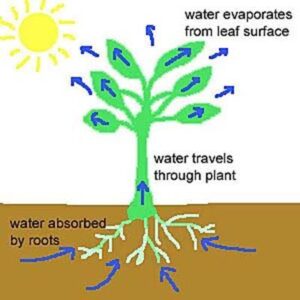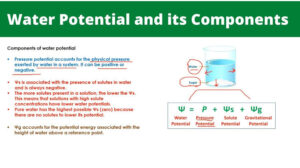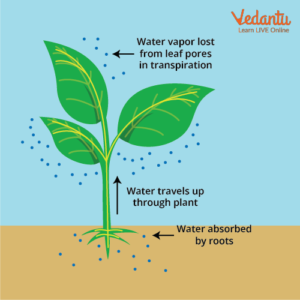Back to: Botany 400 Level
My brilliant Afrilearn scholar, welcome back! I hope you’re having a great day! Have you ever wondered how water moves from the soil into a plant’s roots, up the stem, and finally to the leaves? How does water know where to go? It’s not magic—it’s science! Today, we’ll be learning about Water Potential and Its Components. By the end of this lesson, you’ll understand how plants control water movement and why this is essential for survival.
Water potential and its components
Imagine you’re drinking a cold bottle of Zobo with a straw. The moment you suck, the drink rises into your mouth. But if you place the straw in the bottle without sucking, nothing happens. This is because the Zobo moves from where it is more concentrated (in the bottle) to where there is less (your mouth).

Plants move water in a similar way. Water always flows from areas of higher water potential (where there is more free water) to areas of lower water potential (where there is less free water). Understanding this process helps farmers, scientists, and agriculturists manage crops better, ensuring they get enough water to grow.
What is Water Potential?
Water potential (Ψw\Psi_w) is the measure of the potential energy of water in a system. It determines the direction in which water moves. Water always moves from a region of higher water potential to a region of lower water potential.
Pure water has the highest water potential (Ψw=0\Psi_w = 0).
When solutes (like salts or sugars) dissolve in water, the water potential decreases (becomes more negative).
In plants, water moves from the soil (high water potential) into the roots (lower water potential) and up to the leaves (even lower water potential).
Components of Water Potential
Water potential is influenced by different factors, which are called its components:
Solute Potential (Ψs\Psi_s) – Effect of Dissolved Substances
Also called osmotic potential, this is the effect of solutes (e.g., salts, sugars) in water.
The more solutes present, the lower the water potential (more negative value).
Example: If you add salt to water, the water potential decreases, making water move into it from a region with higher water potential.
Pressure Potential (Ψp\Psi_p) – Effect of Physical Pressure
This is the pressure exerted by water inside plant cells.
Turgid (firm) plant cells have high pressure potential, helping them stand upright.

Example: When you overfill a water balloon, the pressure increases. Similarly, water-filled plant cells create pressure that keeps the plant firm.
Matric Potential (Ψm\Psi_m) – Effect of Surfaces Binding Water
This refers to how water sticks to surfaces like soil particles or cell walls.
It affects water availability in the soil and plant tissues.
Example: In dry soil, water binds tightly to soil particles, making it harder for plants to absorb it.
Gravitational Potential (Ψg\Psi_g) – Effect of Gravity on Water Movement
Gravity pulls water downward, affecting its movement in plants and soil.
Example: Water drains quickly from sandy soil because of gravity, but in clay soil, it stays longer.
Think about when you soak dried beans in water. The beans absorb water and swell up because the water moves from an area of high water potential (water in the bowl) to an area of lower water potential (inside the beans).
Another example is wilting plants. When the soil becomes dry, its water potential drops. Since the plant roots have a higher water potential than the dry soil, water moves out of the plant, causing it to wilt. But once you water the plant, the soil water potential increases, and water flows back into the plant, making it fresh again!
Summary
Water potential (Ψw\Psi_w) determines the movement of water in plants, from areas of high to low potential. It has four main components:
Solute potential (Ψs\Psi_s) – Water potential decreases when solutes are added.

Pressure potential (Ψp\Psi_p) – Water pressure inside cells keeps plants firm.
Matric potential (Ψm\Psi_m) – Water sticks to soil or cell walls, affecting movement.
Gravitational potential (Ψg\Psi_g) – Gravity pulls water downward.
This knowledge helps in agriculture, irrigation, and understanding how plants absorb water.
Evaluation
- What is water potential, and why is it important in plants?
- How does solute concentration affect water potential?
- Explain the role of pressure potential in keeping plants upright.
- Why do plants wilt when the soil is dry?
Keep learning, my scholar! Every new concept you understand brings you one step closer to mastering plant physiology. Remember, knowledge is power, and you have everything it takes to succeed. Keep shining, and I’ll see you in the next lesson!
